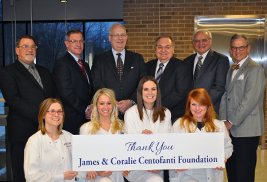Featured Article
Centofanti Gift to Kent State University Helps Complete Health and Science Wing at Kent State Salem
Kent State University President Lester A. Lefton accepted a $700,000 commitment from the James and Coralie Centofanti Foundation that will be used to complete the Health and Sciences Wing at Kent State University at Salem.
read moreOhio Third Frontier Funding Could Lead to New Kent State Spin-Off Technology Companies
Posted Feb. 25, 2013The State of Ohio’s Third Frontier Program recently announced that Kent State University was awarded three of the nine Phase I awards given through its Technology Validation and Start-Up Fund (TVSF). The goal of the TVSF is to create greater economic growth in Ohio-based start-up companies that commercialize technologies developed by Ohio institutions of higher education and other Ohio not-for-profit research institutions.
The university will receive $137,571 for three projects led by faculty research investigators in the Liquid Crystal Institute/Chemical Physics Interdisciplinary Program (LCI/CPIP). The awards are contingent upon Controlling Board approval.
“We are pleased that the Ohio Third Frontier Program continues to see the value and promise of some of our newest technologies,” says Kent State Vice President for Research Grant McGimpsey, Ph.D. “Kent State, and especially the Liquid Crystal Institute, has a solid track record of turning these early investment dollars into real products that lead to start-up companies and high-tech, high-paying jobs right here in Northeast Ohio.”
The university was awarded $50,000 for its project Lightweight and Biocompatible Soft Piezoelectric Fiber Mats, led by Kent State CPIP Professor Antal Jákli, Ph.D., to develop flexible piezoelectric fiber mats, which are capable of changing dimensions when electric current is applied or provide electric signals when pressed. This flexible piezoelectric technology initially has potential applications in low-power displays, braille typing instruments for people with visual impairments and other biological applications.
“Compared to other piezoelectric devices made of ceramics or polymers that are very rigid, this device is more biocompatible because it is as soft as skin tissue,” Jákli says. “I plan to use the $50,000 to hire a postdoc who will work on building prototypes of it for about nine months. After that, we hope to take it to the next level and demonstrate that it will be worthwhile to start a company around this idea.”
Kent State CPIP Interim Director Liang-Chy Chien, Ph.D., was awarded $38,590 to use a liquid crystal display to create a better way to view 3-D images without special glasses. Kent State Professor Deng-Ke Yang was awarded $48,981 to develop novel liquid crystal window technology that does not require a continuous electrical current.
The TVSF supports technologies inside these institutions that need known validation, such as the building of a prototype before a technology is commercially viable and able to support a start-up company. The TVSF also supports Ohio start-up companies that license these technologies with funds to help move the technology forward to successful commercialization.
“These investments support Ohio’s economic development strategy through local partnerships and help move technologies from research and development to commercialization,” says Christiane Schmenk, director of the Ohio Development Services Agency and chair of the Ohio Third Frontier Commission. “Ohio Third Frontier is supporting the development of cutting-edge technologies and early-stage companies to ensure Ohio’s tech-based economy thrives.”
For more information about research at Kent State, visit www.kent.edu/research.
